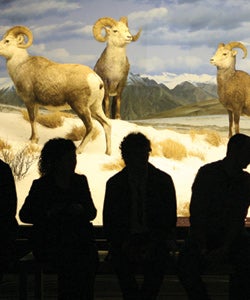Fridays Are Happening
Combining science, music and a late night at the Natural History Museum of Los Angeles County might seem like a strange idea to some. But Michael Quick, executive vice dean in USC College and moderator of the museum’s First Fridays series, thinks, “Museums reaching out to unknown audiences is smart.”
First Fridays runs from January to June on the first Friday of every month, interweaving thematic presentations, up-and-coming indie bands, and food and drink for a relaxed evening that is part social mixer, part science talk.
The series has seen a dramatic rise in attendance since program director Su Oh came on board three years ago, the same time she approached Quick in the hope that he could recommend someone who would assist in coordinating speakers for the science portion of the evening.
“I hate asking people for favors,” Quick said. “So I volunteered myself.”

Michael Quick, executive vice dean in the College, lends his scientific expertise as moderator of the Natural History Museum of Los Angeles County’s First Fridays series. “The museum is the interface between science and the public,” Quick said, “and I just think that’s brilliant.” Photo credit Eric O’Connell
In addition to his position as executive vice dean of the College, Quick is professor of neuroscience in the Department of Biological Sciences. When he was brought in to work on First Fridays in 2008, there were only a few weeks before the start of the next series. With a limited amount of time to prepare, Quick applied a neuroscience perspective to the theme, “The Age of Mammals,” and drafted speakers such as fellow USC College professor Antonio Damasio, director of the USC Brain and Creativity Institute.
Last year’s theme was an even bigger hit, though Quick admits it was difficult to find a fresh perspective on the 150th anniversary of The Origin of Species and 200th birthday of Charles Darwin himself. Most of the lectures, no matter how diverse their original topics, funneled down to a debate on Darwinism versus creationism, and many of the experts in the field had already done the lecture circuit as “everyone was doing Darwin.”
That hasn’t prevented people from showing up. First Fridays has become “a victim of its own success,” Quick said. One event during the Darwin series was almost shut down by the fire department for over-crowding. On average, there are 1,500 to 1,800 attendees during the course of the night, and they aren’t just coming for the bands. The talks are so popular that a second lecture had to be added to the program of each evening.
Quick attributes the growth of interest to the longevity of the program, choosing topics that are relatable, and catering to audience participation by quickly opening up the floor to questions. One of his favorite past events was a lecture on elephant communication that was completely packed, and even prompted questions from young children.
Once a theme is decided upon (this season is “Southern California Science”), Quick often seeks out speakers online, such as Nate Lewis, professor at the California Institute of Technology and expert on solar energy, then calls them, and tells them he’s looking for people to “give a talk you’d give to a freshman humanities or undeclared student.”

Between sets and lectures, visitors explore the Hall of Mammals. Photo courtesy of the Natural History Museum and Ryan Miller/Capture Imaging.
The audience is mostly 18- to 30-year olds, but there is a healthy mix of families and “more experienced folks.” You don’t have to be a genius to attend; moms and dads with no education beyond high school come with their children to learn and explore.
“We try to communicate a little bit of cool science,” Quick said.
As moderator, Quick believes it’s his job to keep the vibe casual. He might open with a humorous anecdote — such as First Fridays was selected as one of 13 “Best Places to Meet Women” by Men’s Health magazine. After warming up the crowd, he turns the microphone over to the speaker.
Quick is interested in brainstorming with museum directors about integrating more programs with the College and its students. The museum, located on Exposition Boulevard, is just a short walk from USC’s University Park campus. At present USC College paleontologists work with paleontologists from the museum, and some museum faculty teach in the College.
“The museum is the interface between science and the public,” Quick said, “and I just think that’s brilliant.”
For more information on the Natural History Museum of L.A. County’s First Fridays series, visit nhm.org/site/activities-programs/first-fridays.
Read more articles from USC College Magazine’s Spring/Summer 2010 issue.